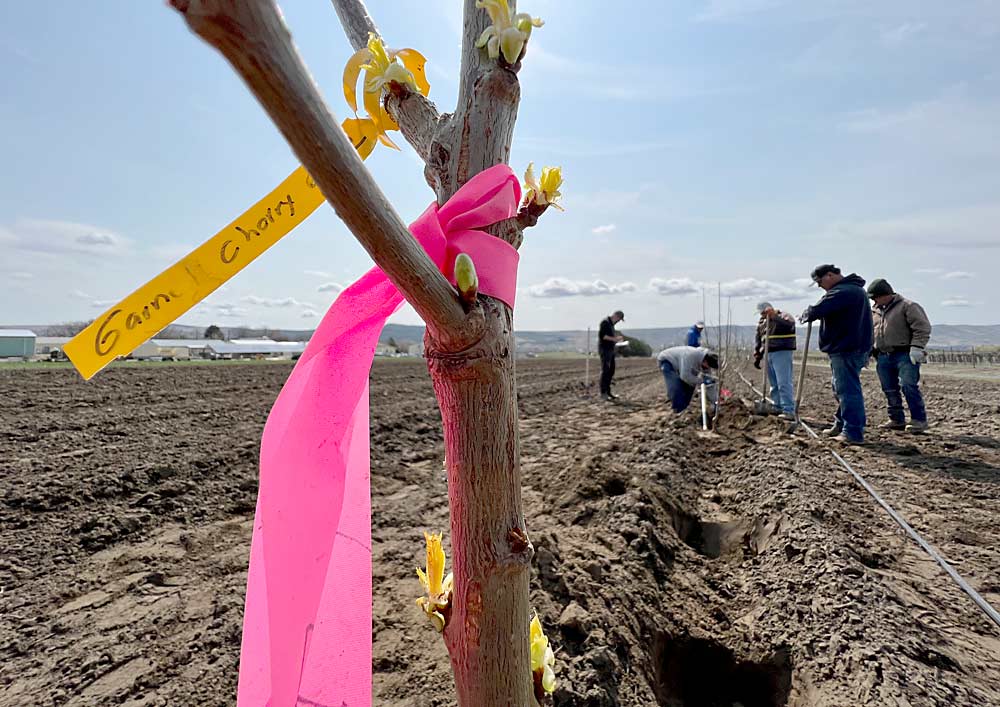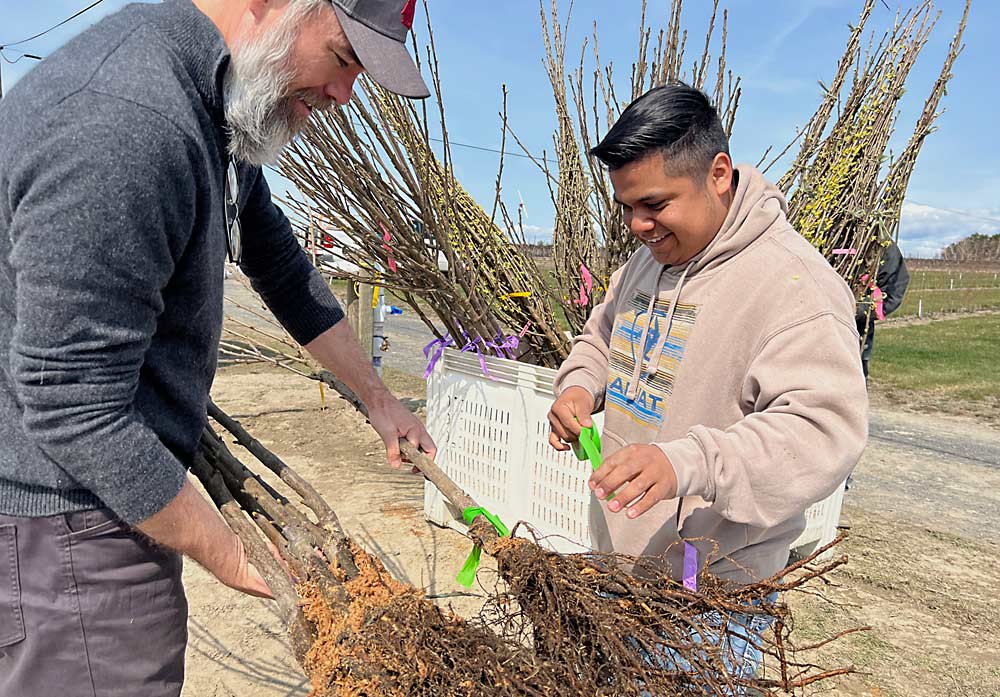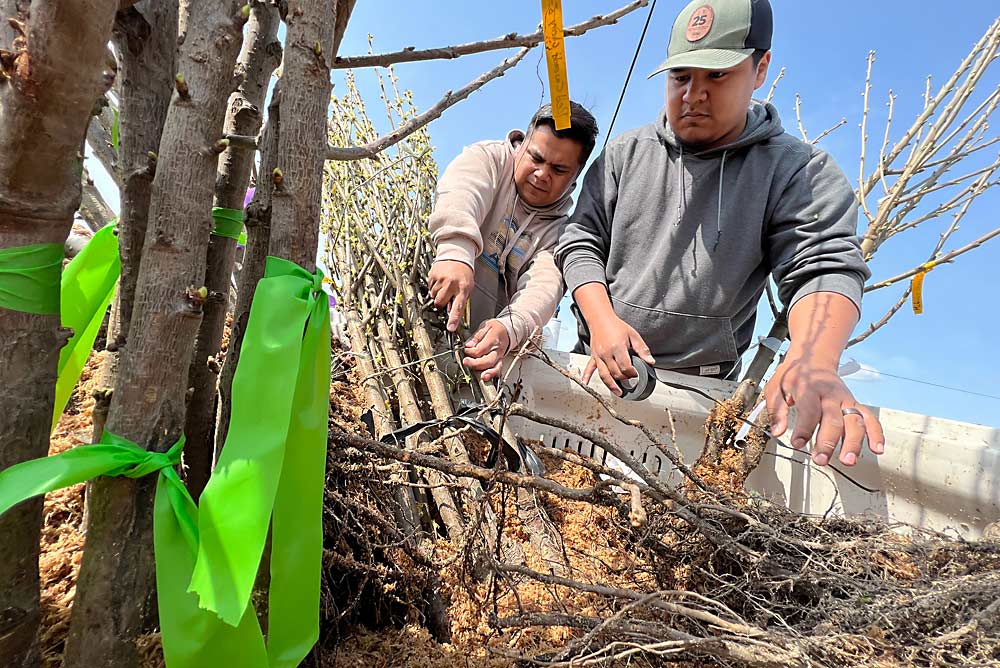
The Northwest’s next cherry cultivars will have to produce big, firm, flavorful fruit, ideally harvesting before or after current industry standards.
It’s a tall order, and growers want to see that performance themselves before making a big investment in a new variety. That’s why Washington State University researchers just planted a new variety demonstration block at the Irrigated Agriculture Research and Extension Center in Prosser.
“We’ve never planted a cultivar demonstration in the 20 years I’ve been at WSU, so I felt it was long overdue,” said Matt Whiting, WSU tree fruit physiologist. “The concept is pretty straightforward: Plant a bunch of new, newly released or soon-to-be-released cultivars from around the world that people are talking about, in an orchard at WSU where we can get empirical evaluations and provide those data for industry.”
The first trees went in the ground this spring, but the project is several years in development. Whiting and extension specialist Bernardita Sallato worked with the nursery industry to identify cultivars to include.
“It’s a spot for growers to go look — is it big, is it firm, is it early, is it late?” said Bill Howell, manager of the Northwest Nursery Improvement Institute, the industry organization providing financial support to the project. Nurseries and their customers are always on the lookout for the next best cultivars, he said. “The more we know about the next ones, the better our decisions will be.”

This year, Whiting planned to plant eight new varieties alongside Chelan, Sweetheart and Benton standards, all propagated on Gisela 12 rootstock to have consistent precocity across the block. Biringer Nursery of Mount Vernon propagated most of the trees, Howell said.
Whiting plans to train the block in a UFO-style vertical wall with four or five upright leaders, but if he finds cultivars that would be better suited to a different approach, he can adapt.
“The goal is to have a systematic testing ground where we can generate data that would just give growers an additional level of confidence in making their investment decisions,” Whiting said.
Trial cultivars planted in the first wave include: Black Lake, McGinty, Denfer, Red Cascade, Cheery Grand, Cheery Glow, Cheery Moon and Garnet.
Garnet was developed by prolific private California breeder Marvin Nies and patented in 1979. Denfer is a red cultivar, bred by France’s National Research Institute for Agriculture, Food and the Environment, or INRAE. It’s a midseason cherry that promises consistent production and size, according to the website of the variety owner, CEP Innovation.
The three Cheery cultivars are products of International Fruit Genetic’s low-chill breeding program, which has now released 10 varieties. Cheery Grand is an early red cherry, three days ahead of Brooks, that averages 9-row fruit, according to IFG’s website. Cheery Glow is a blush cherry that ripens 10 days ahead of Rainier, and Cheery Moon is an early red cherry with harvest timing three days ahead of Santina.

Over the next few years, Whiting plans to plant more cultivars as budwood becomes available from the Clean Plant Center Northwest, including the advance selections from WSU’s cherry breeding program.
“Sometimes it takes a couple of years to get ahold of trees, so hopefully we build the pipeline and get the word out,” Whiting said. “We want people to know that this is a place where they can have new selections evaluated systematically in comparison with other promising new selections.”
Grower tours will likely start in 2025, which will offer the first real look at fruit, he said.
—by Kate Prengaman
Nurseries also tout new options
Two Washington nurseries are also promoting new cherry cultivars.
One new early option is ZillaZeus, a new cultivar available from Willow Drive Nursery. Often referred to simply as Zeus, the variety stems from a chance mutation found in a Zillah-area Bing block, where the grower noticed a branch blooming far ahead of everything else, said Willow Drive salesman Tyson McCallum.
“It’s three to five days ahead of Chelan, I would say confidently,” McCallum said. The fruit average 8 to 9 row and have high sugar.
The cultivar’s early bloom requires careful pollinizer selection, and he’s testing some California varieties. “From a Washington standpoint, I want guys to sandwich it with Chelan and Samba,” McCallum said.
Last season’s cold spring took out the crop, he said, but this year, if the season goes well, Willow Drive is planning a field day in Zillah to introduce the variety to interested growers.
Another new option in the Northwest is Garnet Girl. The cultivar is a self-fertile, dark-red cherry developed by the Vineland Research and Innovation Centre in Canada, and it was recently licensed by Brandt’s Fruit Trees of Yakima. It ripens between Chelan and Tieton and averages 9-row fruit, said Kevin Brandt.
“We believe that the selection is an excellent fit for the Pacific Northwest, as it falls into the earlier end of cherry harvest and is able to achieve the size profile that is becoming standard in today’s market,” said Brandt, vice president of the nursery.
—K. Prengaman






Leave A Comment